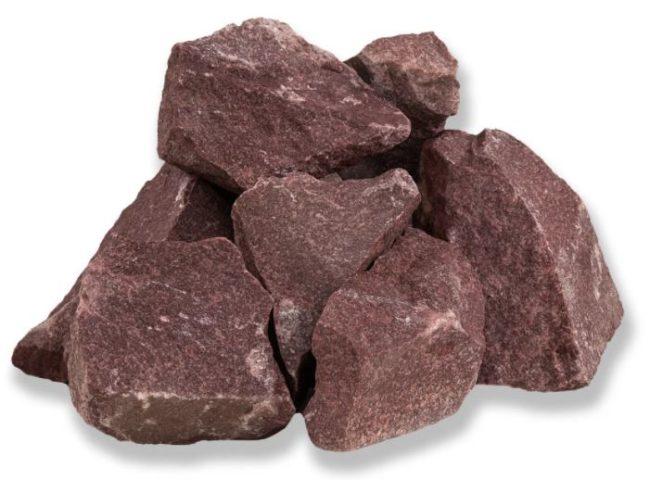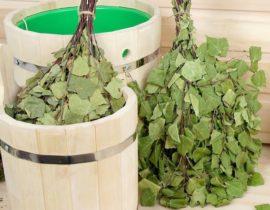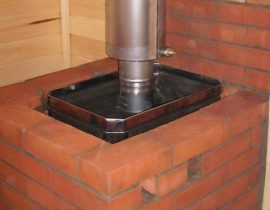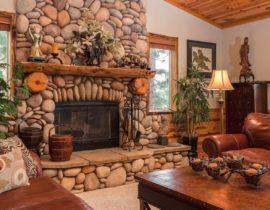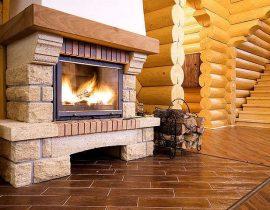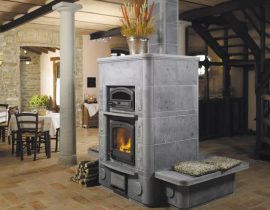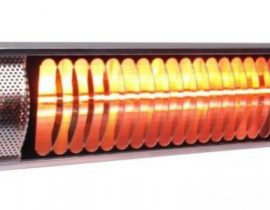When arranging a bath or a steam room, the choice of stones for filling the stove, finishing the walls and individual elements of the room is important. It is also useful for those who like to take a steam bath to know what function the stones perform and how to choose them correctly.
Content
Appointment of stones
In baths and saunas, stones are needed to accumulate and retain heat and create steam. With its help, a temperature rise is achieved that can be kept at the same level.
Steam can be made dry or wet as desired. In the first case, the air will warm up to 120 ° C. High temperature is the hallmark of dry steam. A little moisture makes it easier to withstand heating. In this case, a harsh effect on the body occurs, however, the therapeutic effect of visiting saunas with dry steam is more effective.
Wet steam, characteristic of the Russian bath, is generated by pouring boiling water over stones. In modern buildings, closed heaters with water supply are used for this.
When heated, moist air acts like inhalation, but you can’t stay in a steam room at a temperature of 100 ° C for a long time. This is especially true for people with cardiovascular pathologies. The air temperature is easily adjustable and in most cases is maintained within the range of 60 - 80 °C.
What are the requirements for stones
There are a number of requirements for the quality of minerals, ignorance of which can lead to undesirable consequences. Many natural materials contain harmful elements that subsequently come out with steam.
When choosing stones on your own, you should take into account the objects near which they were collected. When buying quality products in a store, the packaging indicates that it has passed radiation control.
The main criteria that stones for a sauna or bath must meet:
- heat resistance. Stones must withstand the temperature created in the steam room and not crack in the fire. To check the cobblestone, it should be heated and placed in cold water. A good quality stone will not crack or burst from this;
- size and shape. They are selected depending on the type of furnace. For capacious wood stove large cobblestones from 80 to 120 mm in diameter are suitable. When using small electric furnaces, you need to pick up smaller stones - with a diameter of about 50 mm. The form of minerals can be different. Laying flat small stones is easier.
- heat capacity, which determines the ability to accumulate heat and release heat. Stones that retain heat for a long time are heavier and have a dense, uniform structure.
The best option for baths with a heater are salt bricks, which can be purchased at specialty stores.
In addition to the basic qualities that allow you to keep warm, the aesthetic side of the issue is of no small importance. Combinations of different minerals are able to harmonize with the overall interior of the steam room. Natural materials can be processed - polished or rolled.
Thus, the boulders are given a more rounded shape. Many stones look good in their original form. You can create complex combinations. For example, shungite goes well with jadeite, basalt with white quartz or colored quartzite.
Natural and artificial stones
Not all rocks are suitable for use in a bath. Minerals that fall into the category of metamorphic and sedimentary rocks are not a suitable option, as they have water-absorbing properties and have a low level of thermal stability. Such stones burst quickly under the influence of fire.
The higher the density index, the better the heat is retained and the longer its return lasts. The content of silica in materials should not exceed 50%. Otherwise, they will be unsuitable for laying the stove in the steam room.
All the necessary properties have:
A good alternative to natural fillers is pebbles. You can stock up on it yourself, and despite the fact that it requires an annual replacement, you can do it for free. The composition of the pebbles includes rocks suitable for the bath. Unlike river pebbles, sea pebbles contain useful substances, including iodized salt.
The use of artificial materials for bookmarking is the most economical option. These are products made of cast iron, alloy steel, ceramics and concrete. They can be made in the form of balls or have a different shape.
Artificial fillers do not contain useful substances, but they are environmentally friendly and do not emit toxins.They have the ability to accumulate and retain heat, do not crack when exposed to high temperatures, have good heat capacity and can last for a long time.
Popular minerals and their characteristics
The characteristics of the stones most suitable for use in baths are laid out below:
 Chromite
Chromite
Heat capacity kJ/kg*С0 — 0.92
Natural mineral of igneous origin, 90% composed of chrome spinels. It contains olivine, serpentine and pyroxene, and may contain elements of Mg and Zn.
It is characterized by high specific gravity, heat capacity, strength, non-toxic and does not interact with the liquid medium even at high temperatures.
The stone has long been used in folk medicine to treat pathologies of the reproductive system. It has powerful energy, improves immunity, treats colds.
 Soapstone
Soapstone
Heat capacity kJ/kg*С0 — 0.98
Eco-friendly material that has the ability to retain heat throughout the day. Allows you to get a large amount of steam with a minimum number of cobblestones. Requires piercing and rinsing before first use to avoid dust formation.
It has a lot of healing properties: it strengthens the body, adds vitality, improves immunity, promotes the synthesis of vitamin D in the body, and normalizes metabolism. Talcochlorite emits soft heat, similar to the sun.
 white quartz
white quartz
Heat capacity kJ/kg*С0 — 0.75
Not too strong and durable material, can crack when heated, but has excellent aesthetic qualities. Translucent white minerals look stylish in the oven and release a lot of steam.
A distinctive feature of white quartz is the release of fragrant ozone during sudden cooling after heating. The mineral stimulates brain activity, has a beneficial effect on the state of the nervous system and enriches tissues with oxygen.
Dunite
Heat capacity kJ/kg*С0 — 1.00
 The black rock, consisting of olivine and pyroxene, does not emit harmful impurities when heated.
The black rock, consisting of olivine and pyroxene, does not emit harmful impurities when heated.
Differs in low coefficient of linear expansion and high specific heat capacity. Due to this, it does not crack and withstands high temperature loads.
The stones do not have decorative properties, but their natural irregular shape provides a large evaporation area. By interacting with carbon dioxide, peridotite purifies the air, helps to cure colds, and stabilizes blood pressure.
 Quartzite
Quartzite
Heat capacity kJ/kg*С0 — 0.70
Strong, wear-resistant cobblestones with high density and low water absorption. Quartzite does not lose its external qualities during prolonged use, does not crumble and does not emit harmful substances.
It comes in purple, yellow and grey. It is useful in the treatment of vegetovascular diseases and pulmonary pathologies. Helps improve blood circulation, normalizes blood pressure, heals joints.
 Basalt
Basalt
Heat capacity kJ/kg*С0 — 0.84
basalt or volcanic is characterized by natural strength and resistance to high temperatures. It has very low water absorption properties and has a high heat capacity.
The mineral is able to intensively generate healing steam. Increases pressure, helps with colds, joint inflammation, migraines, nervous system disorders and eczema.
Bath attendants' advice
The selection of a suitable filler is very important for attendants, but in addition to this, stones must be used correctly. Before laying, it is recommended to wash and dry them. For the lower layers, large fragments are more suitable, which retain heat for a long time.
You can use basalt, peridotite or cast iron balls. Above are medium and small minerals with healing properties: jadeite, quartzite. The laying of stones does not require compaction, although it should be sufficiently dense and have about 10% air gaps.
Video tips for choosing stones for a bath








